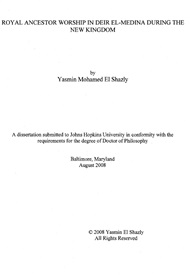
The subject of this dissertation is "Royal Ancestor Worship in Deir el-Medina during the New Kingdom." This work attempts to increase our understanding of why this form of ancestor worship was adopted by the inhabitants of Deir el-Medina, the status of the royal ancestors relative to the great gods, what determined the choice of royal ancestor(s) a person called upon, and did social status affect the manner in which a dedicant is represented interacting with a royal ancestor on a monument? In order to answer these questions monuments, mainly from Deir el-Medina, on which royal ancestors are represented were collected and categorized based on object and scene type, and the manner in which the dedicant is represented interacting with the royal ancestor(s).
The conclusions reached are that deceased royal figures were called upon as "intermediaries" between the great gods and the inhabitants of Deir el-Medina. Their status was slightly lower than that of the great gods, yet they possessed enough divinity to be able to intercede on behalf of the worshipper(s). The choice of royal ancestors represented on a monument from Deir el-Medina was based on several possible factors.
Most monuments, displaying the names and/or representations of royal ancestors, included Amenhotep I and Ahmose-Nefertary as the patron gods of the village, as well as other members of the Ahmosid line. In some cases the dedicant depicted deceased kings whose reigns he had witnessed, or deceased kings in whose cults he had been involved, or a sequence of royal ancestors, usually based on members of the Ahmosid line, and often including the Thutmosids and kings regarded as dynastic founders, such as Nebhepetre Montuhotep, whose mortuary temple at Deir el-Bahri and the role it played in the Beautiful Feast of the Valley evidently influenced his veneration by the inhabitants of Deir el-Medina. Another factor that probably dictated the inclusion of a certain figure within a sequence was the existence of a nearby temple for the cult of that figure, through which the procession of the Beautiful Feast of the Valley may have passed.

